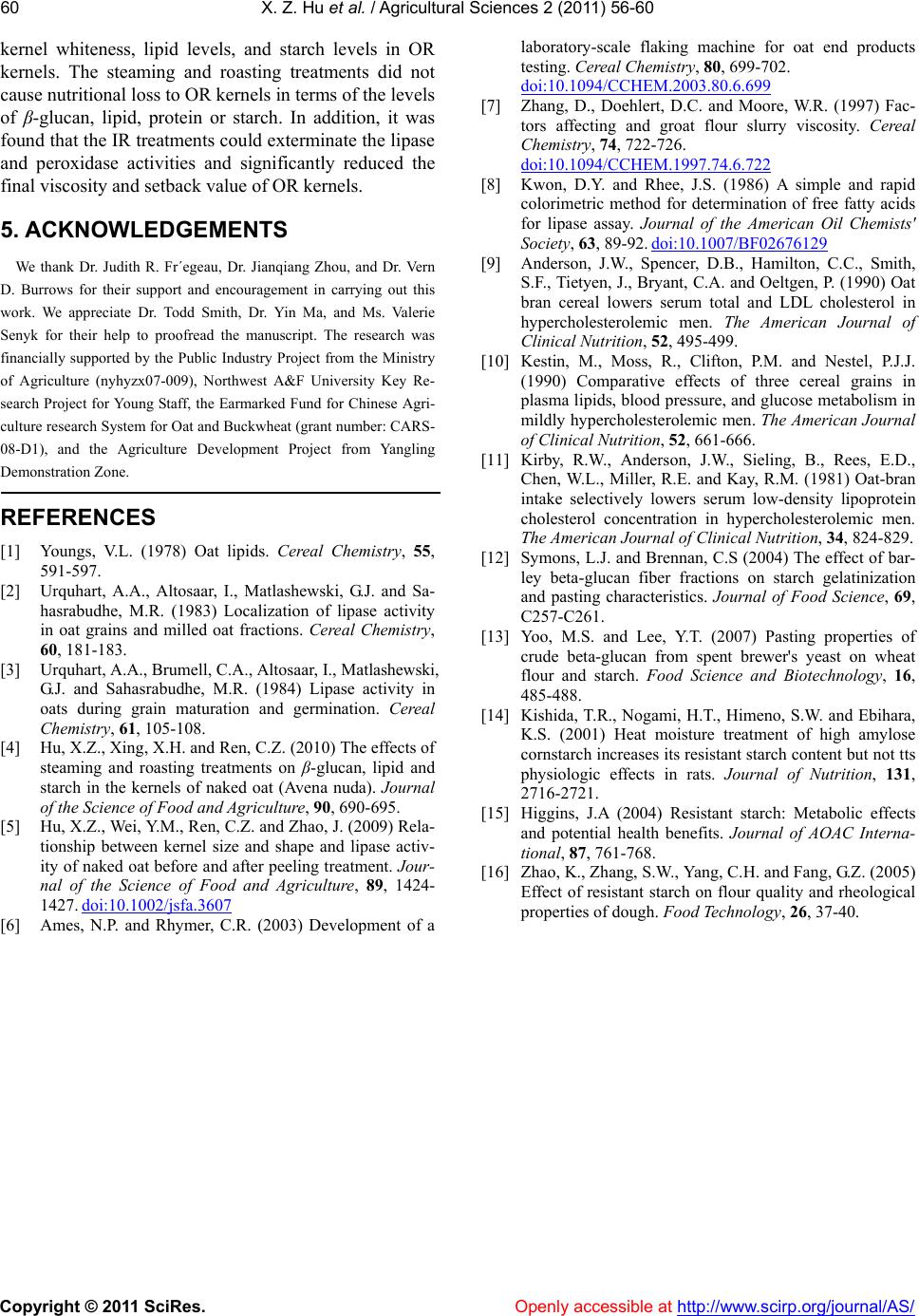
X. Z. Hu et al. / Agricultural Sciences 2 (2011) 56-60
Copyright © 2011 SciRes. Openly accessible at http://www.scirp.org/journal/AS/
60
kernel whiteness, lipid levels, and starch levels in OR
kernels. The steaming and roasting treatments did not
cause nutritional loss to OR kernels in terms of the levels
of β-glucan, lipid, protein or starch. In addition, it was
found that the IR treatments could exterminate the lipase
and peroxidase activities and significantly reduced the
final viscosity and setback value of OR kernels.
5. ACKNOWLEDGEMENTS
We thank Dr. Judith R. Fr´egeau, Dr. Jianqiang Zhou, and Dr. Vern
D. Burrows for their support and encouragement in carrying out this
work. We appreciate Dr. Todd Smith, Dr. Yin Ma, and Ms. Valerie
Senyk for their help to proofread the manuscript. The research was
financially supported by the Public Industry Project from the Ministry
of Agriculture (nyhyzx07-009), Northwest A&F University Key Re-
search Project for Young Staff, the Earmarked Fund for Chinese Agri-
culture research System for Oat and Buckwheat (grant number: CARS-
08-D1), and the Agriculture Development Project from Yangling
Demonstration Zone.
REFERENCES
[1] Youngs, V.L. (1978) Oat lipids. Cereal Chemistry, 55,
591-597.
[2] Urquhart, A.A., Altosaar, I., Matlashewski, G.J. and Sa-
hasrabudhe, M.R. (1983) Localization of lipase activity
in oat grains and milled oat fractions. Cereal Chemistry,
60, 181-183.
[3] Urquhart, A.A., Brumell, C.A., Altosaar, I., Matlashewski,
G.J. and Sahasrabudhe, M.R. (1984) Lipase activity in
oats during grain maturation and germination. Cereal
Chemistry, 61, 105-108.
[4] Hu, X.Z., Xing, X.H. and Ren, C.Z. (2010) The effects of
steaming and roasting treatments on β-glucan, lipid and
starch in the kernels of naked oat (Avena nuda). Journal
of the Science of Food and Agriculture, 90, 690-695.
[5] Hu, X.Z., Wei, Y.M., Ren, C.Z. and Zhao, J. (2009) Rela-
tionship between kernel size and shape and lipase activ-
ity of naked oat before and after peeling treatment. Jour-
nal of the Science of Food and Agriculture, 89, 1424-
1427. doi:10.1002/jsfa.3607
[6] Ames, N.P. and Rhymer, C.R. (2003) Development of a
laboratory-scale flaking machine for oat end products
testing. Cereal Chemistry, 80, 699-702.
doi:10.1094/CCHEM.2003.80.6.699
[7] Zhang, D., Doehlert, D.C. and Moore, W.R. (1997) Fac-
tors affecting and groat flour slurry viscosity. Cereal
Chemistry, 74, 722-726.
doi:10.1094/CCHEM.1997.74.6.722
[8] Kwon, D.Y. and Rhee, J.S. (1986) A simple and rapid
colorimetric method for determination of free fatty acids
for lipase assay. Journal of the American Oil Chemists'
Society, 63, 89-92. doi:10.1007/BF02676129
[9] Anderson, J.W., Spencer, D.B., Hamilton, C.C., Smith,
S.F., Tietyen, J., Bryant, C.A. and Oeltgen, P. (1990) Oat
bran cereal lowers serum total and LDL cholesterol in
hypercholesterolemic men. The American Journal of
Clinical Nutrition, 52, 495-499.
[10] Kestin, M., Moss, R., Clifton, P.M. and Nestel, P.J.J.
(1990) Comparative effects of three cereal grains in
plasma lipids, blood pressure, and glucose metabolism in
mildly hypercholesterolemic men. The American Journal
of Clinical Nutrition, 52, 661-666.
[11] Kirby, R.W., Anderson, J.W., Sieling, B., Rees, E.D.,
Chen, W.L., Miller, R.E. and Kay, R.M. (1981) Oat-bran
intake selectively lowers serum low-density lipoprotein
cholesterol concentration in hypercholesterolemic men.
The American Journal of Clinical Nutrition, 34, 824-829.
[12] Symons, L.J. and Brennan, C.S (2004) The effect of bar-
ley beta-glucan fiber fractions on starch gelatinization
and pasting characteristics. Journal of Food Science, 69,
C257-C261.
[13] Yoo, M.S. and Lee, Y.T. (2007) Pasting properties of
crude beta-glucan from spent brewer's yeast on wheat
flour and starch. Food Science and Biotechnology, 16,
485-488.
[14] Kishida, T.R., Nogami, H.T., Himeno, S.W. and Ebihara,
K.S. (2001) Heat moisture treatment of high amylose
cornstarch increases its resistant starch content but not tts
physiologic effects in rats. Journal of Nutrition, 131,
2716-2721.
[15] Higgins, J.A (2004) Resistant starch: Metabolic effects
and potential health benefits. Journal of AOAC Interna-
tional, 87, 761-768.
[16] Zhao, K., Zhang, S.W., Yang, C.H. and Fang, G.Z. (2005)
Effect of resistant starch on flour quality and rheological
properties of dough. Food Technology, 26, 37-40.